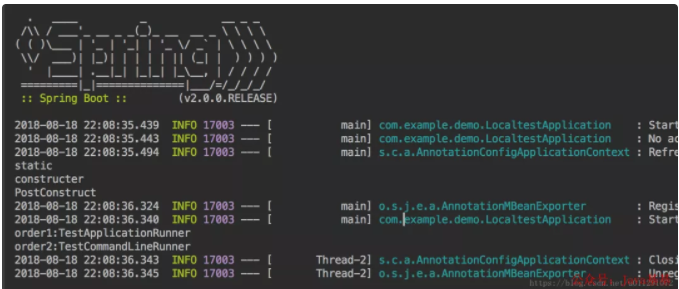SpringBoot启动自动执行代码
怪盗柯南丶kid1412 人气:0前言
目前开发的SpringBoot项目在启动的时候需要预加载一些资源。而如何实现启动过程中执行代码,或启动成功后执行,是有很多种方式可以选择,我们可以在static代码块中实现,也可以在构造方法里实现,也可以使用@PostConstruct注解实现。
当然也可以去实现Spring的ApplicationRunner与CommandLineRunner接口去实现启动后运行的功能。在这里整理一下,在这些位置执行的区别以及加载顺序。
java自身的启动时加载方式
static代码块
static静态代码块,在类加载的时候即自动执行。
构造方法
在对象初始化时执行。执行顺序在static静态代码块之后。
Spring启动时加载方式
@PostConstruct注解
PostConstruct注解使用在方法上,这个方法在对象依赖注入初始化之后执行。
ApplicationRunner和CommandLineRunner
SpringBoot提供了两个接口来实现Spring容器启动完成后执行的功能,两个接口分别为CommandLineRunner和ApplicationRunner。
这两个接口需要实现一个run方法,将代码在run中实现即可。这两个接口功能基本一致,其区别在于run方法的入参。ApplicationRunner的run方法入参为ApplicationArguments,为CommandLineRunner的run方法入参为String数组。
何为ApplicationArguments
官方文档解释为:
”Provides access to the arguments that were used to run a SpringApplication.
在Spring应用运行时使用的访问应用参数。即我们可以获取到SpringApplication.run(…)的应用参数。
Order注解
当有多个类实现了CommandLineRunner和ApplicationRunner接口时,可以通过在类上添加@Order注解来设定运行顺序。
代码测试
为了测试启动时运行的效果和顺序,编写几个测试代码来运行看看。
TestPostConstruct
@Component
public class TestPostConstruct {
static {
System.out.println("static");
}
public TestPostConstruct() {
System.out.println("constructer");
}
@PostConstruct
public void init() {
System.out.println("PostConstruct");
}
}TestApplicationRunner
@Component
@Order(1)
public class TestApplicationRunner implements ApplicationRunner{
@Override
public void run(ApplicationArguments applicationArguments) throws Exception {
System.out.println("order1:TestApplicationRunner");
}
}TestCommandLineRunner
@Component
@Order(2)
public class TestCommandLineRunner implements CommandLineRunner {
@Override
public void run(String... strings) throws Exception {
System.out.println("order2:TestCommandLineRunner");
}
}执行结果

总结
Spring应用启动过程中,肯定是要自动扫描有@Component注解的类,加载类并初始化对象进行自动注入。加载类时首先要执行static静态代码块中的代码,之后再初始化对象时会执行构造方法。
在对象注入完成后,调用带有@PostConstruct注解的方法。当容器启动成功后,再根据@Order注解的顺序调用CommandLineRunner和ApplicationRunner接口类中的run方法。
因此,加载顺序为static>constructer>@PostConstruct>CommandLineRunner和ApplicationRunner.
加载全部内容